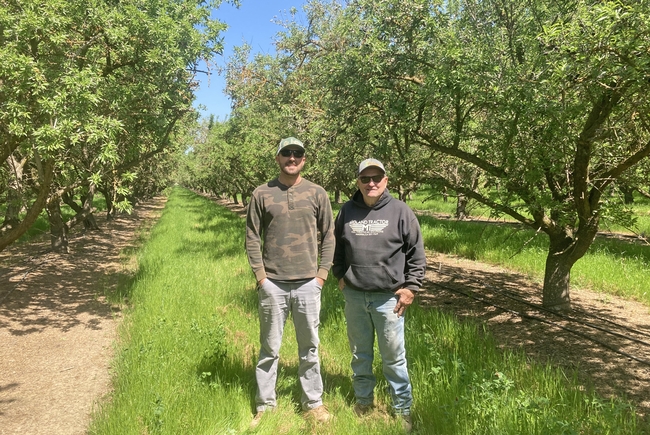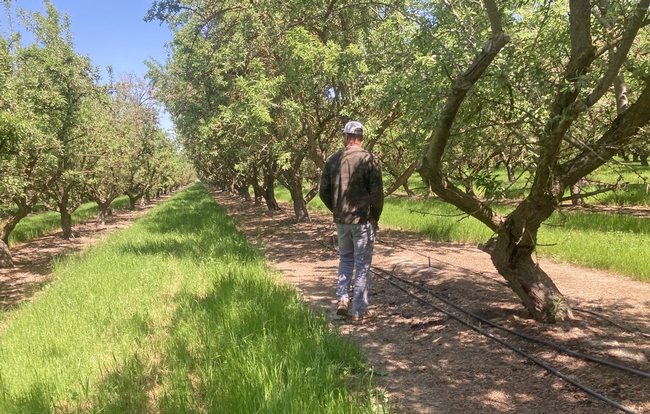
Ten years ago, Rob Schuh was on the verge of retiring. As a lifelong farmer, he had become disillusioned by how his work had become a series of numbers – adding and subtracting pounds of fertilizer, herbicide, and pesticide every year. Then he discovered the concept of regenerative farming, alongside his son-in-law Andrew Carroll. Regenerative farming gave Schuh a newfound appreciation for agriculture and the land.
The more he learned, the more regenerative farming made sense when combined with his decades of experience treating his 210 acres of almond orchards in Chowchilla, California as a living, complex ecosystem. Schuh began to develop a more holistic approach for his orchard that led him to implement additional climate-smart agricultural practices that would benefit his soils.
The two climate-smart practices that Schuh decided to implement were cover cropping and compost application. He began incorporating compost in 2015 and cover cropping in 2016, while also reducing many of his inputs including synthetic fertilizer and chemical pesticides. While he has become reengaged with his land and excited about farming again, this shift has also had significant benefits for his bottom line.

Schuh plants a diverse cover crop mix – in 2021 it included 16 species – in his orchard rows every fall with a rented seed drill. When surface water is available, he floods his orchards once a month. When it is not available, the winter rains still provide enough water to produce a healthy cover crop stand. He tries to keep his cover crops growing as long as possible throughout the spring and early summer, mowing every few weeks with a flail mower and finally using a stick jack to clear the rows of residue before harvest.
Schuh has saved an average of $38,000 per year on farm inputs since beginning cover cropping and applying compost. He has reduced his synthetic nitrogen application from around 300 units/acre per year of Urea Nitrate-32 or UN32 to about 75, and plans to continue reducing. He applies almost no herbicides and pesticides now, and doesn't need to treat for navel orangeworm. He started applying nutrients through aerial sprays to achieve better precision to his tree canopies.
“Cover crops needing extra water is a myth” – Rob Schuh
For irrigation, Schuh has a mix of microsprinklers and double-line drip, and also floods once a month when water is available. Since beginning to cover crop, he has noticed better water retention and infiltration in his soil. He has reduced his irrigation sets from 48 to 36 hours. Even in years where no surface water is available, he still gets decent cover crop stands in the middle of his rows from just rainwater.
When it comes to labor, it has been difficult to quantify costs on his farm, as most of it is done by himself and his son-in-law. However Schuh estimates that labor has stayed about the same since implementing these practices. They of course spend more time planting the cover crops, mowing them, and applying compost. However, they significantly reduced their pesticide applications and no longer need to pay for orchard sanitation and mummy shakes.
Since Schuh implemented cover crops six years ago, there has been no statistically significant impact on yields. Incorporating these climate-smart practices into the orchard allowed him to reconnect to his passion for farming and agriculture.
Schuh and Carroll are avid learners about regenerative practices and the effect these practices have on the land. Hearing from farmers like Schuh and Carroll provides other farmers and ranchers with a better understanding of how implementing climate-smart practices can be accomplished in similar systems.
Thank you to T Double R Farms for your contributions! This project was supported in part by the California Department of Food and Agriculture. View the full economic case study for more information.
For any questions regarding this blog post please contact us at: climatesmartcesteam@groups.ucdavis.edu.